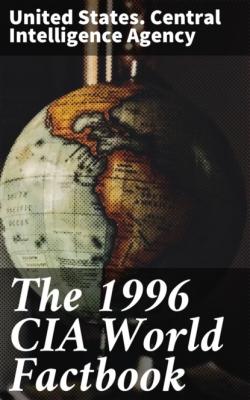The 1996 CIA World Factbook. United States. Central Intelligence Agency
Читать онлайн.| Название | The 1996 CIA World Factbook |
|---|---|
| Автор произведения | United States. Central Intelligence Agency |
| Жанр | Социология |
| Серия | |
| Издательство | Социология |
| Год выпуска | 0 |
| isbn | 4057664582324 |
Endangered Species, Nuclear Test Ban, Ozone Layer Protection;
signed, but not ratified - Desertification, Law of the Sea
Geographic note: landlocked; almost the precise center of Africa
People———
Population: 3,274,426 (July 1996 est.)
Age structure:
0–14 years: 44% (male 724,914; female 718,423)
15–64 years: 52% (male 839,118; female 877,069)
65 years and over: 4% (male 53,418; female 61,484) (July 1996 est.)
Population growth rate: 2.08% (1996 est.)
Birth rate: 39.97 births/1,000 population (1996 est.)
Death rate: 17.64 deaths/1,000 population (1996 est.)
Net migration rate: −1.53 migrant(s)/1,000 population (1996 est.)
Sex ratio:
at birth: 1.03 male(s)/female
under 15 years: 1.01 male(s)/female
15–64 years: 0.96 male(s)/female
65 years and over: 0.87 male(s)/female
all ages: 0.98 male(s)/female (1996 est.)
Infant mortality rate: 111.7 deaths/1,000 live births (1996 est.)
Life expectancy at birth: total population: 45.86 years male: 45.03 years female: 46.71 years (1996 est.)
Total fertility rate: 5.41 children born/woman (1996 est.)
Nationality: noun: Central African(s) adjective: Central African
Ethnic divisions: Baya 34%, Banda 27%, Sara 10%, Mandjia 21%,
Mboum 4%, M'Baka 4%, Europeans 6,500 (including 3,600 French)
Religions: indigenous beliefs 24%, Protestant 25%, Roman Catholic 25%, Muslim 15%, other 11% note: animistic beliefs and practices strongly influence the Christian majority
Languages: French (official), Sangho (lingua franca and national
language), Arabic, Hunsa, Swahili
Literacy: age 15 and over can read and write (1995 est.)
total population: 60%
male: 68.5%
female: 52.4%
Government—————
Name of country:
conventional long form: Central African Republic
conventional short form: none
local long form: Republique Centrafricaine
local short form: none
former: Central African Empire
abbreviation: CAR
Data code: CT
Type of government: republic;
Capital: Bangui
Administrative divisions: 14 prefectures (prefectures, singular - prefecture), 2 economic prefectures* (prefectures economiques, singular - prefecture economique), and 1 commune**; Bamingui-Bangoran, Bangui**, Basse-Kotto, Gribingui*, Haute-Kotto, Haute-Sangha, Haut-Mbomou, Kemo-Gribingui, Lobaye, Mbomou, Nana-Mambere, Ombella-Mpoko, Ouaka, Ouham, Ouham-Pende, Sangha*, Vakaga
Independence: 13 August 1960 (from France)
National holiday: National Day, 1 December (1958) (proclamation of
the republic)
Constitution: passed by referendum 29 December 1994; adopted 7
January 1995
Legal system: based on French law
Suffrage: 21 years of age; universal
Executive branch:
chief of state: President Ange PATASSE (since 22 October 1993)
elected for a five-year term by universal suffrage; election last
held 19 September 1993 (next to be held NA 1998); results - PATASSE
received 52.45% of the votes and Abel GOUMBA received 45.62%
head of government: Prime Minister Jean-Paul NGOUPANDE (since 6 June
1996); appointed by the president
cabinet: Council of Ministers; appointed by the president
Legislative branch: unicameral
National Assembly (Assemblee Nationale): elections last held 19
September 1993 (next to be held NA); results - percent of vote by
party NA; seats - (85 total) MLPC 33, RDC 14, PLD 7, ADP 6, PSD 3,
others 22
note: the National Assembly is advised by the Economic and Regional
Council (Conseil Economique et Regional); when they sit together
they are called the Congress (Congres)
Judicial branch: Supreme Court (Cour Supreme), judges appointed by
the president; Constitutional Court, judges appointed by the
president
Political parties and leaders: Alliance for Democracy and Progress
(ADP), Tchapka BREDE; Central African Democratic Assembly (RDC),
Andre KOLINGBA; Civic Forum (FC), Gen. Timothee MALENDOMA; Liberal
Democratic Party (PLD), Nestor KOMBO-NAGUEMON; Movement for the
Liberation of the Central African People (MLPC), the party of the
president, Ange Felix PATASSE; Movement for Democracy and
Development (MDD), David DACKO; Marginal Movement for Democracy,
Renaissance and Evolution (MDREC), Joseph BENDOUNGA; Patriotic Front
for Progress (FFP), Abel GOUMBA; Social Democratic Party (PSD),
Enoch Derant LAKOUE
International organization participation: ACCT, ACP, AfDB, BDEAC,
CCC, CEEAC, ECA, FAO, FZ, G-77, IBRD, ICAO, ICRM, IDA, IFAD, IFC,
IFRCS, ILO, IMF, Intelsat, Interpol, IOC, ITU, NAM, OAU, UDEAC, UN,
UNCTAD, UNESCO, UNIDO, UPU, WCL, WHO, WIPO, WMO, WTrO
Diplomatic representation in US: chief of mission: Ambassador Henri KOBA chancery: 1618 22nd Street NW, Washington, DC 20008 telephone: [1] (202) 483–7800, 7801 FAX: [1] (202) 332–9893
US diplomatic representation: chief of mission: Ambassador Mosina H. JORDAN embassy: Avenue David Dacko, Bangui mailing address: B. P. 924, Bangui telephone: [236] 61 02 00, 61 25 78, 61 02 10 FAX: [236] 61 44 94
Flag: four equal horizontal bands of blue (top), white, green, and yellow with a vertical red band in center; there is a yellow five-pointed star on the hoist side of the blue band
Economy———
Economic overview: Subsistence agriculture, together with forestry, remains the backbone of the economy of the Central African Republic (CAR), with more than 70% of the population living in outlying areas. The agricultural sector generates half of GDP. Timber has accounted for about 13% of export earnings and the diamond industry for nearly 80%. Important constraints to economic development include the CAR's landlocked position, a poor transportation system, a largely unskilled work force, and a legacy of misdirected macroeconomic policies. A major plus is the large forest reserves, which the government is moving to protect from overexploitation. The 50% devaluation of the currencies of 14 Francophone African nations on 12 January 1994 had mixed effects on the CAR's economy. While diamond, timber, coffee, and cotton exports increased - leading GDP to increase by 5.5% - inflation rose to 45%, fueled
